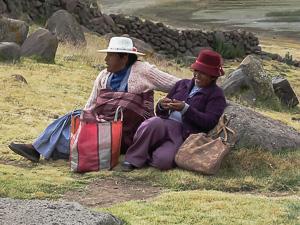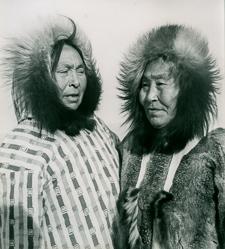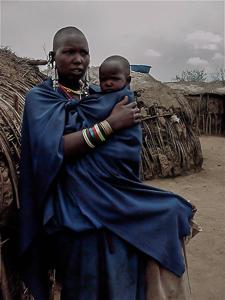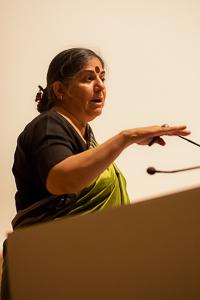

The central tenet of ecofeminism is that social and environmental issues are not separate, that the causes for the mistreatment of women, people of color and the environment stem from the same place. Therefore, from an ecofeminist perspective, it is best to view all of these issues collectively.
Ecofeminism puts forth the idea that life in nature is maintained through cooperation, mutual care and lovei. It is an activist and academic movement, and its primary aim is to address and eliminate all forms of domination while recognizing and embracing the interdependence and connection humans have with the earth.
The Roots and Flowering of the Ecofeminist Movement
Ecofeminism, “a new term for ancient wisdom,” developed out of various social movements: the feminist, peace and ecology movements in the late 1970s and early 1980s.ii According to many adherents to ecofeminist philosophy, French writer Francoise d’Eaubonne coined the term ecofeminism in 1974 to demonstrate the potential for women to make significant contributions to an ecological revolution.iii The term was popularized through its use in protests against environmental destruction. According to Charlene Spretnak:
Ecofeminism grew out of radical or cultural feminism, which holds that identifying the dynamics behind the dominance of male over female is the key to comprehending every expression of patriarchal culture with its hierarchical, militaristic, mechanistic and industrialist forms.iv
Radical or cultural feminism is sometimes referred to as big picture feminism because it examines assumptions, values and fears in an effort to holistically understand patriarchal culture.v Ecofeminists began as feminists who sought to create a fundamental shift in consciousness with respect to the domination of women and nature, rather than simply accepting women’s participation in the public sphere.vi Early feminist and environmentalist efforts have allowed women to become more visible and accepted in a typically male-dominated public sphere, and though early ecofeminist thinkers sought to reinvigorate ideas surrounding feminism and the environment by drawing forth a conceptual framework as opposed to a political or bureaucratic approach, these ideas brought environmentalism to public attention through activism and political maneuvering. The idea was to change the way people think at their core instead of only changing laws, policies or institutions, which can often have superficial results, as they do not address fundamental attitudes and assumptions that underlie ideology. As Spretnak states:
We [ecofeminists] support and join our sisters fighting for equal pay, for battered women’s shelters, for better child care, and for all the efforts to stop the daily exploitation and suffering of women. But we see those efforts as bandages on a very unhealthy system.vii
Curing the unhealthy system, rather than just patching it up, allows for a more sustainable future.

The second path was the introduction to nature-based religion, specifically spirituality involving the Goddess: “In the mid-seventies many radical/cultural feminists experienced the exhilarating discovery, through historic and archaeological sources, of a religion that honored the female and seemed to have as its ‘Good Book’ nature itself.”ix As Riane Eisler has famously inferred, prehistoric societies worshipping the goddess also worshipped nature and peace. These were societies in which women were not subordinate to men and earth was not seen as an object for exploitation and domination. “The rediscovery of these traditions signals a way out of our alienation from one another and from nature.”x
The third and final path into ecofeminism was environmentalism.xi Many women with careers in public policy, technology, science and environmental studies already had a connection to feminism; they were particularly interested in career-blocking issues and began to shift their focus toward ecofeminism, which gave their work new meaning. Once the seeds of ecofeminism were planted, they took root and started to flower into a movement.
Two important conceptual themes often discussed amongst ecofeminists include the recognition of the vital link between social dominance, oppression, and feminism, and the notion of human and nature interconnectedness. First, for ecofeminists, evaluating oppressive power structures is the first step toward a new standard for a human/nature relationship. They assert that powerlessness and inequality – perpetuated by a modern, male-dominated social structure – are the root causes of environmental degradation and the pressures it puts on humans, such as famine and a lack of access to clean water.xiii
The second major theme, interconnectedness, proposes that every organism on earth, as well as inorganic matter and entire environments, serve a larger purpose, as all forms of matter are connected by complex webs belonging to a reciprocal system:
Ecofeminists understand human beings as not being separate from or above nature. They are one small part of a whole, rather than the pinnacle of nature. In separating nature from persons, humanity creates a concept of nature which is made up of dead, unintelligent matter.xiv

Given that the subjugation of women and nature is a social construct, not a biological determinant, these relationships have the potential to change. Ecofeminism provides a forum for this change. With burgeoning environmental destruction and historically oppressive power structures, it is important to examine closely alternative solutions to the woes of our communities, land and the earth itself.
While ecofeminists have made many connections between women and nature, the three ties that most strongly bind them are empirical, the conceptual and epistemological.
Empirical data supports the notion that women often bear the responsibility of feeding and caring for their children while maintaining a household. In poorer countries especially, these duties make women and their children more vulnerable to the effects of environmental deterioration as they desperately search for basic resources with little to no financial and communal support.xv
Conceptually, women are associated either culturally or symbolically with the earth:
The claim is that dualistic conceptual structures identify women with femininity, the body, Earth, sexuality and flesh: and men with masculinity, spirit, mind and power. Dualisms such as reason/emotion, mind/body, culture/nature, heaven/Earth, and man/woman converge. This implies that men have innate power over both women and nature. This dualistic structure was championed in the Greek world, perpetuated by Christianity, and reinforced later during the scientific revolution.vxi
Finally, the epistemological connection results from the theoretical connections between women and nature; this approach suggests that because women are most adversely affected by environmental problems and generally associated with nature, they are in an epistemological privileged place.xvii This means women are in a position to facilitate the creation of practical and intellectual ecological paradigms.
The Empirical: Reproductive and Child Concerns
In addition to the social abuse and stratification women suffer under patriarchy, as sustainers/creators for/of new life and generally thought to be natural nurturers, women are more susceptible to biological problems accompanying a polluted environment.
One ecological impact on women affects child bearing. Too often, toxins in the air, soil and water have detrimental consequences for women and children; birth defects, disease, miscarriage and infertility are among the possible outcomes of a compromised environment. Furthermore, children may suffer after ingesting elevated levels of harmful chemicals such as PCBs (polychlorinated biphenyl), PBBs (polybrominated biphenyl) and dioxins in their mothers’ milk.vxiii When a woman’s body holds toxic levels of such pollutants, both she and her children are at risk and can perpetuate the problem.
Ecological impacts extend beyond childbirth and infant care. Women (particularly those in less developed countries) are often responsible for providing basic resources, like water, food, fuel and healthcare, while men move to urban settings for work. “Women in the Third World form the base of ecological activism. They are more likely than men to be tied to their living environment through a deep knowledge of plants animals and local ecology.”xix
Women, and subsequently children, have become the most vulnerable to ecological destruction, but they are also seen as being the closest to nature, making their love and attention towards environmental issues the most plausible solution for a better future. Recognizing these intersections makes ecofeminism a valuable lens through which to view the important connections between struggling women and children and their environments, as well as an outlet for mutual support and advocacy.
The Conceptual: The Past and Future of the Gaia Tradition
We have been taught, directly or indirectly, that human civilization is built upon a rugged and intense desire to dominate and oppress, that once “man” figured out how to domesticate plants and animals, slavery and warfare were quick to follow. However, new archeological evidence points to something contrary: “If we look closely at the new data we now have about the first agrarian or Neolithic societies, we actually see that all the basic technologies on which civilization is based were developed in societies that were not male dominated and warlike.”xx
Furthermore, anthropologists today commonly agree that the domestication of plants was developed by women. The ancient civilizations that humanity is built upon were not founded by war mongering and oppression, and evidence suggests that women and nature were highly regarded in many cultures. Many ancient civilizations were peaceful, and both men and women lived in harmony with one another and nature. Most notably, “the life-giving powers incarnated in women’s bodies were given the highest social value,”xxi thus faith in the goddess and in nature was heavily prevalent in ancient civilizations, reaffirming the principle of associating women with nature. This was known as the Gaia Tradition, wherein practitioners view the earth (Gaia) as a living system designed to nurture and maintain life, and it has been part of the human faith for millennia, though these belief systems are now largely extinct.
The Epistemological: Healing a “Lobotomy”
In his essay “How to heal a lobotomy,” Brian Swimme postulates that the patriarchal mindset of modern, Western culture is comparable to a frontal lobotomy, in that by only seeing the world through a male-dominated lens, we lose touch with our surroundings and parts of our brains are rendered useless (virtually removed) from lack of use. He is a scientist attempting to change the way his field works, confessing that science – with its insistence on analysis, computation and categorization – can blind people to the whole reality.
Swimme suggests that scientific data be interpreted in a more holistic way, encompassing categorically “masculine” traits, such as logic and reason, with typically “feminine traits,” such as intuition and creativity. Swimme states:
To get knowledge of the parts, we [scientists] had to become partial. But the one-eyed vision of partial minds is exactly what is killing us. To understand the scientific facts we need the wisdom of the whole, the wisdom germane to the consciousness celebrated by ecofeminism.”xxii

Who are Today’s Ecofeminists? What are they doing? How to Get Involved
Currently, ecofeminism has had only budding effects on the sciences or in the realm of conservation; largely, ecofeminism is most easily detected through academia and more theoretical frameworks. It is still in the development stage. However, there have been significant contributions on behalf of ecofeminist thinkers and writers who have paved the way for grassroots activism and helped spread the word about this young discipline. Popular ecofeminist influences such as Gloria Orenstein, an author and professor of topics relating to ecofeminism; Vandana Shiva, a popular ecofeminist, philosopher, author and environmental activist; Maria Mies, a retired sociology professor and author; Starhawk a writer and activist; Charlene Spetnak, another author and activist; Karen Warren, a philosophy professor; and Carol Adams, a prominent author, continue to shape the emergence of ecofeminism through scholarship, community organizing and international outreach.
While ecofeminist activism, notably in the realm of environmentalism, may be fledgling, there are various outlets for the kinds of activism that filter strategy and policy development through this particular lens, and there is always room for ecofeminist thought in any women’s or environmental movement. Some examples of ecofeminist groups include:
As climate change continues to affect all corners of the world, it is becoming more and more important that our views of the environment and our relationship to the planet begin to evolve into something more holistic. Ecofeminsm provides an additional alternative to ecological thought and social organizing, while promising solidarity among women and those who suffer from oppression, as well as sympathizers.
i Maria Mies and Vandana Shiva, in “Introduction: Why we wrote this book together,” Ecofeminsm (Halifax, Nova Scotia: Fernwood publications, 1993), 6.
ii Mies and Shiva, “Introduction,” 13.
iii Fred Besthorn and Diane Pearson McMillen, “The Oppression of Women and Nature: Ecofeminism as Framework for an Expanded Ecolofical Social Work,” Families in Society, 83-3 (2002), 224.
iv Charene Spretnak, “Ecofeminism: Our Roots and Our Flowering,” Reweaving the World: the emergence of Ecofeminism, ed. Irene Diamond et al (San Francisco: Sierra Club Books, 1990), 5.
v Spretnak, “Ecofeminism: Our Roots and Our Flowering,” 9.
vi Irene Diamond and Gloria Feman Orenstein, eds., introduction to Reweaving the World: the emergence of Ecofeminism (San Francisco: Sierra Club Books, 1990), x.
vii Spretnak, “Ecofeminism: Our Roots and Our Flowering,” 9.
viii Spretnak, “Ecofeminism: Our Roots and Our Flowering,” 5.
ix Spretnak, “Ecofeminism: Our Roots and Our Flowering,” 5.
x Riane Eisler, “The Gaia Tradition and the Partnership Future: an Ecofeminist Manifesto,” Reweaving the World: the emergence of Ecofeminism (San Francisco: Sierra Club Books, 1990), 34.
xi Spretnak, “Ecofeminism: Our Roots and Our Flowering,” 4.
xii Spretnak, “Ecofeminism: Our Roots and Our Flowering,” 6.
xiii Besthorn and McMillen, “The Oppresion of Women and Nature: Ecofeminism as Framework for Expanded Ecolofical Social Work,” 225.
xiv Besthorn and McMillen, “The Oppresion of Women and Nature: Ecofeminism as Framework for Expanded Ecolofical Social Work,” 226.
xv Mies and Shiva, “Introduction,” 84.
xvi Heather Eaton and Lois Ann Lorenzten, “Ecofeminism: An Overview,” Forum on Religion and Ecology (Yale School of Forestry and Environmental Studies), retrieved from the web on May 26, 2012.
xvii Eaton and Lorenzten, “Ecofeminism: An Overview.”
xviii Lin Nelson, “The Place of Women in Polluted Places,” Reweaving the World: the emergence of Ecofeminism (San Francisco: Sierra Club Books, 1990), 178.
xix Nelson, “The Place of Women in Polluted Places,” 185.
xx Eisler, “The Gaia Tradition and the Partnership Future: an Ecofeminist Manifesto,” 25.
xxi Eisler, “The Gaia Tradition and the Partnership Future: an Ecofeminist Manifesto,” 24.
xxii Brian Swimme, “How to Heal a Lobotomy,” Reweaving the World: the emergence of Ecofeminism (San Francisco: Sierra Club Books, 1990), 17.
xxiii Chris Cuomo, “Towards Thoughtful Ecofeminist Activism,” Ecological Feminist Philosophies, ed. Karren J. Warren (Bloomington, Indiana: Indiana University Press, 1996), 43.
Photos are copyright protected through Flickr Creative Commons Attribution License 2.0 Generic and may not be reproduced without permission. Copyright information for the photos are as follows: (1) Indigenous Women, photo courtesy of David Stanley; (2) Alaska, photo courtesy of Elisabeth Meyer and the Preus Museum; (3) Massai Woman, photo courtesy of Kathryn and Jonmikel Pardo; (4) Taushik Mandal, photo courtesy of the American Center Mumbai; (5) Vandana Shiva, photo courtesy of postwachstum.